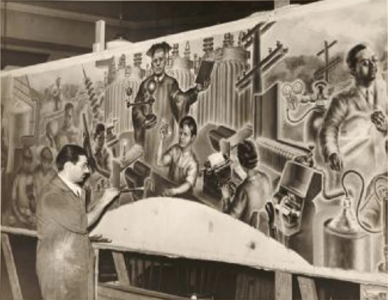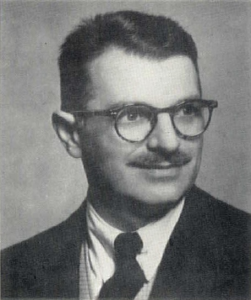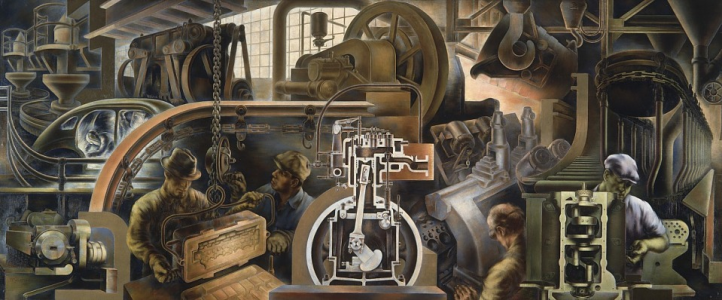

Biography
Marvin Beerbohm was born in Toronto, Canada in 1908. His family moved to Detroit, MI in 1923, and Beerbohm attended the school of the Society of Arts and Crafts from 1928-1932. After graduating, he worked for awhile designing store window displayed. He became a U.S. citizen in 1936, after which he painted murals for WPA programs.
Beerbohm's paintings were exhibited at the Corcoran Gallery in Washington, DC, the Detroit Institute of Arts (1939) and the Carnegie International in Pittsburgh (1941). He painted a mural for the Rochester, MI High School ("Industrial Environment of Rochester High School," 1938) and another for the Detroit Public Library ("Automotive Industry," 1941). He painted two Post Office murals: "Pioneer Group at the Red Rock Line -- 1845" (1941) in Knoxville, IA and "Belding Brothers and Their Silk Industry" (1943) in Belding, MI.
During World War II Beerbohm worked illustrating manuals for tanks. After the war he painted and designed stained glass windows. He taught art in Detroit high schools, art schools and community centers in Michigan, including giving free instruction at the Detroit Art Institute and demonstrations of painting techniques. He painted the mural "Adventures in Time" for the Harlan Electric Company in Southfield, MI in 1955. Beerbohm died in North Olmstead, OH in 1981.

Critical Analysis
Marvin Beerbohm was one of many artists who had created significant work during the Depression but struggled to maintain an artistic career following World War II. Taste in art had changed, and government support for the arts had shifted abruptly. Programs that had favored paintings of the American Scene or celebrated the triumphs of labor and industry had disappeared, and by the 1960s official government organs were actively promoting Abstract Impressionism worldwide as America's new art. Painters like Beerbohm were marginalized in this environment. Fortunately many of Beerbohm's murals have been preserved, with, for example, his dramatic "Automotive Industry," originally commissioned for the Detroit Public Library now on display at the Smithsonian's American Art Museum.
"Automotive Industry" is a truly remarkable work of art. The bulk of the mural, painted in somber tones, shows men at work in all phases of the manufacturing of a car. Molten steel is being poured in the background; a worker is assembling upholstery inside a partly-finished vehicle; and workers in the foreground are handling massive components of the car's engine. But featured in the center of the painting is a cutaway illustration of a piston and crankshaft, perhaps Beerbohm's homage to the tank manuals of his war days. But this image is so bright, formal and central to the painting that it shines almost like a religious icon - a glorification, perhaps, of the end result of the workers' arduous and tedious labor.
Murals
- Knoxville, Iowa - Post Office: Pioneer Group at the Red Rock line -- 1845
- Belding, Michigan - Post Office: Belding Brothers and Their Silk Industry